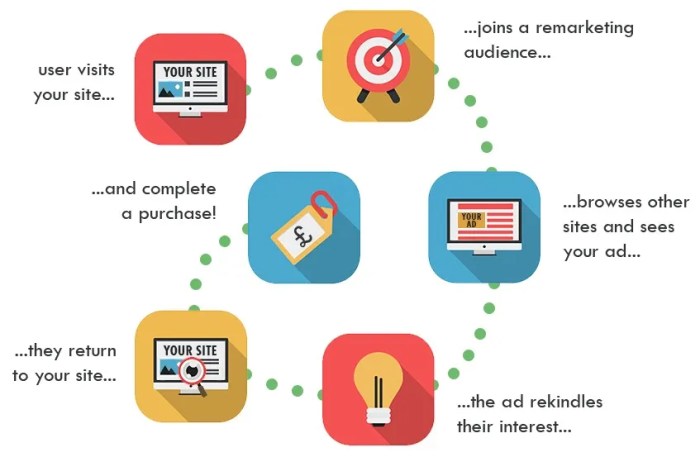Retargeting Ads Guide is the go-to resource for navigating the world of digital marketing with finesse. From defining retargeting ads to optimizing their performance, this guide has got you covered with all the must-know insights delivered in an engaging style.
Introduction to Retargeting Ads

Retargeting ads are a crucial component of digital marketing strategies, aimed at re-engaging users who have previously visited a website. These ads work by tracking users’ online behavior through cookies and displaying targeted ads to them as they browse other websites or social media platforms.
How Retargeting Ads Work
Retargeting ads utilize tracking pixels or cookies to identify users who have interacted with a website but did not complete a desired action, such as making a purchase or filling out a form. These users are then targeted with personalized ads based on their previous interactions, encouraging them to return to the website and complete the desired action.
- Retargeting ads can be displayed across various platforms, including social media, search engines, and other websites in the form of banner ads, pop-ups, or sponsored content.
- By targeting users who have already shown interest in a product or service, retargeting ads have a higher chance of converting leads into customers, ultimately increasing sales and ROI.
- Retargeting ads can also help businesses increase brand awareness and stay top-of-mind with potential customers, leading to improved customer retention and loyalty.
Benefits of Using Retargeting Ads for Businesses
Retargeting ads offer several advantages for businesses looking to enhance their digital marketing efforts and drive conversions.
- Increased Conversion Rates: By targeting users who have already shown interest in a product or service, retargeting ads have a higher chance of converting leads into customers.
- Improved ROI: Retargeting ads are cost-effective and can yield a higher ROI compared to traditional advertising methods, as they target users who are more likely to convert.
- Enhanced Brand Awareness: By displaying personalized ads to users across various platforms, retargeting ads help businesses stay top-of-mind with potential customers, increasing brand awareness and recognition.
- Customer Retention: Retargeting ads can help businesses retain existing customers by engaging them with relevant offers or promotions, leading to improved customer loyalty and repeat purchases.
Types of Retargeting Ads: Retargeting Ads Guide
Retargeting ads come in various forms, each with its unique approach to re-engaging with potential customers who have shown interest in a product or service. Understanding the different types of retargeting ads is crucial for tailoring your marketing strategy effectively.
Pixel-Based Retargeting
Pixel-based retargeting involves placing a tracking pixel on your website, which then tracks visitors’ actions and allows you to display targeted ads to them as they browse other websites. This type of retargeting is effective in reminding users about products they viewed but did not purchase.
List-Based Retargeting
List-based retargeting involves uploading a list of customer information, such as email addresses or phone numbers, to a retargeting platform. This allows you to target specific individuals with personalized ads based on their previous interactions with your brand.
Email Retargeting
Email retargeting involves sending follow-up emails to users who have visited your website but did not complete a desired action, such as making a purchase. By sending targeted emails with product recommendations or special offers, you can encourage these users to return and convert.
Display Retargeting vs. Social Media Retargeting
Display retargeting involves showing ads to users on various websites across the internet, while social media retargeting focuses on displaying ads to users on social media platforms like Facebook, Instagram, or LinkedIn. Display retargeting helps reach users across different online platforms, while social media retargeting leverages the user data available on social media platforms for more targeted advertising.
Choosing the Right Type of Retargeting Ad
Selecting the appropriate type of retargeting ad depends on your specific marketing goals. If you want to reach a broader audience across different websites, display retargeting may be more suitable. On the other hand, if you aim to engage with users on social media platforms where they are already active, social media retargeting could be the right choice. Understanding your target audience and where they spend their time online is essential in determining the most effective retargeting strategy for your business.
Setting up Retargeting Campaigns

When it comes to setting up retargeting campaigns on platforms like Google Ads and Facebook, there are a few key steps to follow to ensure success. First, you’ll need to create a retargeting pixel and place it on your website to track visitors. Then, you can set up specific audience segments based on their behavior on your site. Finally, you can create compelling ad creatives to target these segmented audiences effectively.
Creating Compelling Ad Creatives
Creating ad creatives for retargeting campaigns requires a different approach than regular ads. You need to remind the audience of their previous interaction with your site while also providing something new and enticing. Use engaging visuals, clear messaging, and a strong call to action to drive conversions. Remember to test different creatives to see what resonates best with your audience.
Segmenting Audiences Effectively, Retargeting Ads Guide
Segmenting your audiences effectively is crucial for retargeting campaigns. You can create segments based on different behaviors such as page views, products viewed, or abandoned carts. This allows you to tailor your ads to specific audience interests and increase the likelihood of conversion. Utilize audience insights and analytics to refine your segments over time for better results.
Optimizing Retargeting Ads
To maximize the effectiveness of your retargeting ads, it’s crucial to continuously monitor and analyze their performance. By keeping a close eye on key metrics, you can identify areas for improvement and make data-driven decisions to optimize your campaigns.
Monitoring and Analyzing Performance
- Track key metrics such as click-through rates, conversion rates, and cost per acquisition.
- Use analytics tools to identify which ads are performing well and which ones need adjustments.
- Monitor the behavior of your retargeted audience to understand their preferences and tailor your ads accordingly.
Optimizing Ad Frequency and Budget Allocation
- Adjust ad frequency to avoid bombarding users with too many ads, which can lead to ad fatigue.
- Allocate your budget strategically based on the performance of different ad sets and channels.
- Experiment with different bidding strategies to find the most cost-effective approach for your campaigns.
A/B Testing for Improved Conversion Rates
- Run A/B tests with different ad variations to see which elements resonate best with your audience.
- Test different ad creatives, messaging, and calls-to-action to optimize for conversions.
- Continuously iterate and refine your ads based on the results of A/B tests to improve overall performance.
Compliance and Privacy Considerations
When running retargeting campaigns, it is crucial to prioritize compliance with data privacy regulations such as GDPR and CCPA. Ensuring that user data is handled responsibly and transparently is key to maintaining trust and credibility with your audience.
Importance of Compliance
- Adhering to GDPR and CCPA regulations helps protect user data and privacy rights.
- Non-compliance can result in hefty fines and damage to your brand reputation.
- By following these regulations, you demonstrate respect for user privacy and build trust with your audience.
Transparency and Opt-Out Options
- Provide clear information to users about how their data is used for retargeting purposes.
- Offer opt-out options for users who do not wish to be targeted by retargeting ads.
- Make it easy for users to access their privacy settings and make informed decisions about their data.
User Experience Impact
- Maintaining a positive user experience is essential for the success of retargeting campaigns.
- Avoid bombarding users with excessive ads or irrelevant content.
- Personalize retargeting ads based on user behavior to enhance relevance and engagement.